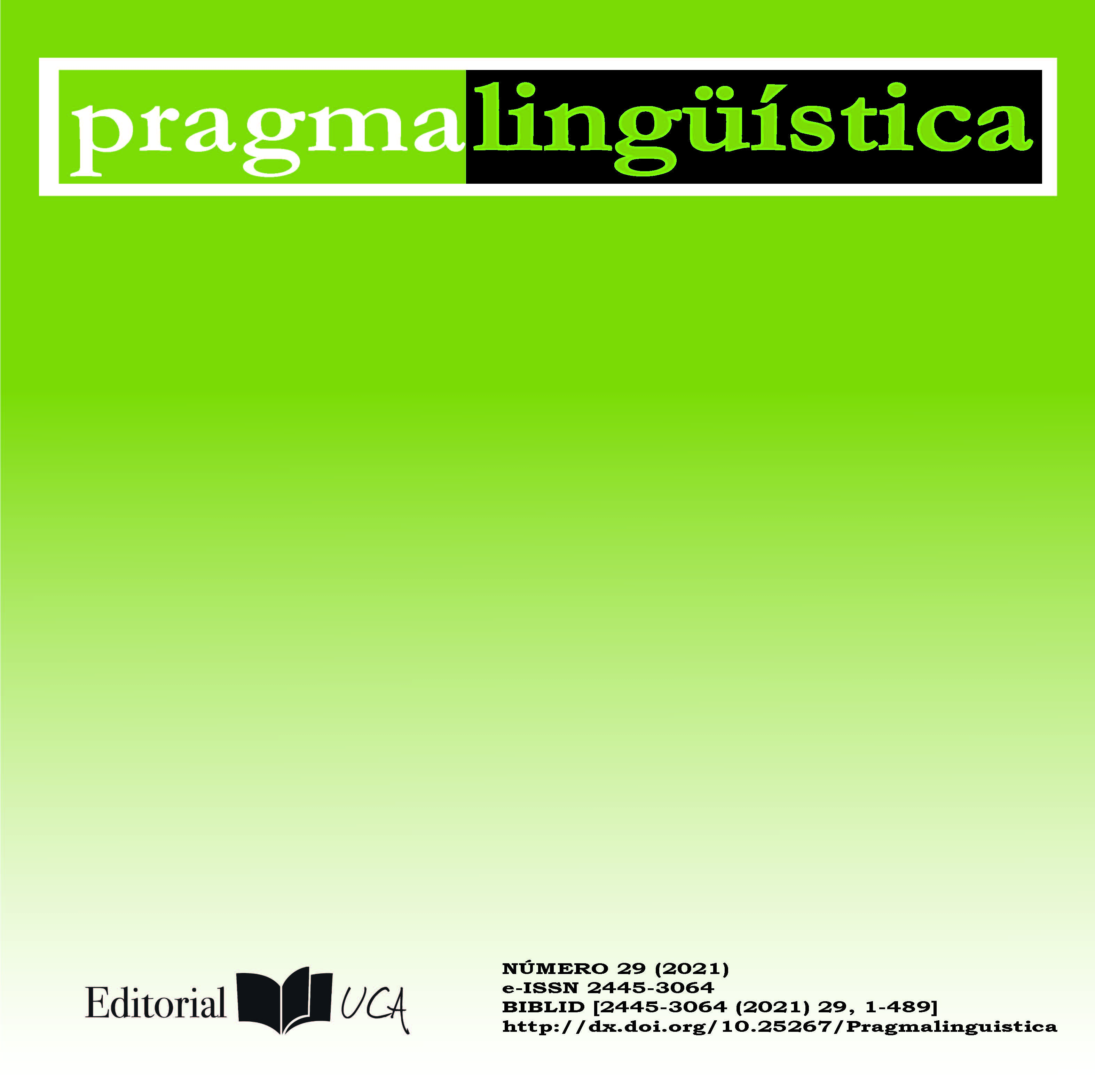Fertilidad léxica en la formación de términos compuestos

DOI
https://doi.org/10.25267/Pragmalinguistica.2021.i29.04Información
Resumen
Los términos compuestos son un tipo de unidad léxica especialmente habitual en el discurso especializado. En ellos se condensa el conocimiento científico-técnico, por lo que su correcto tratamiento es fundamental para la transmisión de la información. Sin embargo, su análisis presenta complicaciones. En este artículo se utilizan técnicas de corpus para investigar la formación conceptual y pragmática de términos compuestos en inglés pertenecientes al ámbito de la energía eólica. En primer lugar, se desambiguó la estructura de los términos compuestos, a cuyos componentes se les asignaron posteriormente categorías semánticas. Tras analizar la relación interna en los términos compuestos, estos se anotaron con roles semánticos. Dicho análisis reveló el microcontexto de cada término, que explica la fertilidad en la formación de los términos compuestos y facilita distintas tareas cognitivas y discursivas, como la traducción.
Palabras clave
Descargas
Cómo citar
Licencia
Derechos de autor 2021 Melania Cabezas-García

Esta obra está bajo una licencia internacional Creative Commons Atribución-NoComercial-SinDerivadas 4.0.
Citas
BOUILLON, P., JEZEK, E., MELLONI, C. Y PICTON, A. (2012): “Annotating qualia relations in Italian and French complex nominals”, Calzolari, N. et al. (eds.), Proceedings of the 8th International Conference on Language Resources and Evaluation (LREC 2012), Estambul: ELRA, pp. 1527–1532. Disponible en: https://archive-ouverte.unige.ch/unige:30915 (Fecha de consulta: 17/11/2020).
BOWKER, L. (1998): “Using Specialized Monolingual Native-Language Corpora as a Translation Resource: A Pilot Study”, Meta, 43(4), pp. 631-651. Disponible en: https://www.erudit.org/fr/revues/meta/1998-v43-n4-meta169/002134ar.pdf (Fecha de consulta: 09/11/2020).
CABEZAS-GARCÍA, M. (2020): Los términos compuestos desde la Terminología y la Traducción. Berlín: Peter Lang. https://doi.org/10.3726/b17354.
CABEZAS-GARCÍA, M. Y FABER, P. (2017): “A Semantic Approach to the Inclusion of Complex Nominals in English Terminographic Resources”, Mitkov, R. (coord.): Computational and Corpus-Based Phraseology, Lecture Notes in Computer Science, 10596, Cham: Springer, pp. 145-159. https://doi.org/10.1007/978-3-319-69805-2_11.
CABEZAS-GARCÍA, M. Y FABER, P. (2018): “Phraseology in specialized resources: an approach to complex nominals”, Lexicography, 5(1), pp. 55-83. https://doi:10.1007/s40607-018-0046-x (Fecha de consulta: 16/11/2020).
CABEZAS-GARCÍA, M. Y LEÓN-ARAÚZ, P. (2019): “On the Structural Disambiguation of Multi-word Terms”, Corpas Pastor, G. y Mitkov, R. (coords.): Computational and Corpus-Based Phraseology, Lecture Notes in Computer Science, 11755, Cham: Springer, pp. 46-60. https://doi:https://doi.org/10.1007/978-3-030-30135-4_4 (Fecha de consulta: 17/11/2020).
CASAS GÓMEZ, M. (2020): “Conceptual relationships and their methodological representation in a dictionary of the terminological uses of lexical semantics”, Fachsprache, 42(1-2), pp. 2-26. https://doi.org/10.24989/fs.v42i1-2.1789
CORPAS PASTOR, G. (1996): Manual de fraseología española. Madrid: Gredos.
DÍAZ HORMIGO, M. T. Y VEGA MORENO, E. (2018): “Algunas de las aplicabilidades actuales de las investigaciones en neología y sobre los neologismos”, Pragmalingüística, 26, pp. 54-68. https://doi.org/10.25267/Pragmalinguistica.2018.i26.03
DOWNING, P. (1977): “On the creation and use of English compound nouns”, Language, 53, pp. 810-842. https://doi.org/10.2307/412913
FABER, P. Y CABEZAS-GARCÍA, M. (2019): “Specialized Knowledge Representation: From Terms to Frames”, Research in Language, 17(2), pp. 197-211. https://doi.org/10.2478/rela-2019-0012
FERNÁNDEZ DOMÍNGUEZ, J. (2019): “Compounds and multi-word expressions in Spanish”, Schlücker, B. (coord.): Complex Lexical Units. Compounds and Multi-Word Expressions, Berlín, Boston: De Gruyter, pp. 189-219.
FERNÁNDEZ SILVA, S. Y KERREMANS, K. (2011): “Terminological variation in source texts and translations: a pilot study”, Meta. Journal des Traducteurs, 56(2), pp. 318-335. Disponible en: https://www.erudit.org/en/journals/meta/2011-v56-n2-meta1821316/1006179ar/ (Fecha de consulta: 04/11/2020).
FILLMORE, C. J. (1982): “Frame semantics”, The Linguistic Society of Korea (coord.): Linguistics in the Morning Calm, Hanshin, pp. 111–137.
GAGNÉ, C. L. (2000): “Relational-Based Combinations Versus Property-Based Combinations: A Test of the CARIN Theory and the Dual-Process Theory of Conceptual Combination”, Journal of Memory and Language, 42, pp. 365-389. https://doi.org/10.1006/jmla.1999.2683
HEID, U. (2001): “Collocations in sublanguage texts: Extraction from corpora”, Wright, S. E. y Budin, G. (eds.): Handbook of Terminology Management. Volume 2: Applications-Oriented Terminology Management, Ámsterdam/Filadelfia: John Benjamins, pp. 788-808. https://doi.org/10.1075/z.htm2.31hei
JESPERSEN, O. (1942): A modern English grammar: On historical principles. Copenhage: Munksgaard.
KAGEURA, K. (2002): The dynamics of terminology: A descriptive theory of term formation and terminological growth. Ámsterdam: John Benjamins.
KILGARRIFF, A., BAISA, V., BUŠTA, J., JAKUBÍČEK, M., KOVÁŘ, V., MICHELFEIT, J., RYCHLÝ, P. Y SUCHOMEL, V. (2014): “The Sketch Engine: ten years on”, Lexicography, 1(1), pp. 7–36. Disponible en: https://link.springer.com/article/10.1007/s40607-014-0009-9 (Fecha de consulta: 27/10/2020).
KIPPER, K., SNYDER, B. Y PALMER, M. (2004): “Extending a verb-lexicon using a semantically annotated corpus”, Calzolari, N. et al. (eds.), Proceedings of the 4th International Conference on Language Resources and Evaluation (LREC 2004), Lisboa: ELRA, pp. 1557-1560. Disponible en: http://www.lrec-conf.org/proceedings/lrec2004/pdf/84.pdf (Fecha de consulta: 10/11/2020).
LAUER, M. (1995): Designing Statistical Language Learners: Experiments on Noun Compounds. Tesis doctoral. Sídney: Macquarie University.
LEÓN-ARAÚZ, P. Y CABEZAS-GARCÍA, M. (2020): “Term and translation variation of multiword terms”, MonTI. Monografías de Traducción e Interpretación, número especial 6, pp. 210-247. https://doi:10.6035/MonTI.2020.ne6.7
LEVI, J. (1978): The Syntax and Semantics of Complex Nominals. Nueva York: Academic Press.
L’HOMME, M. C. (2000): “Understanding Specialized Lexical Combinations”, Terminology, 6(1), pp. 89-110. https://doi.org/10.1075/term.6.1.06hom
MAGUIRE, P., WISNIEWSKI, E. J. Y STORMS, G. (2010): “A corpus study of semantic patterns in compounding”, Corpus Linguistics and Linguistic Theory, 6(1), pp. 49-73. https://doi.org/10.1515/cllt.2010.003
MARTIN, W. (1992): “Remarks on Collocations in Sublanguages”, Terminologie et Traduction, 2(3), pp. 157-164.
MEYER, I. Y MACKINTOSH, K. (1996): “Refining the terminographer’s concept-analysis methods: How can phraseology help?”, Terminology, 3(1), pp. 1-26.
MONTERO MARTÍNEZ, S. (2008): “A constructional Approach to Terminological Phrasemes”, Bernal. E. y DeCesaris, J. (eds.), XIII EURALEX International Congress, Barcelona: Institut Universitari de Lingüística Aplicada/Documenta Universitaria, pp. 1015-1022. Disponible en: https://dialnet.unirioja.es/servlet/articulo?codigo=5065321 (Fecha de consulta: 04/10/2020).
MURPHY, G. L. (1988): “Comprehending complex concepts”, Cognitive Science, 12, pp. 529-562. https://doi.org/10.1207/s15516709cog1204_2
NAKOV, P. (2013): “On the interpretation of noun compounds: syntax, semantics, and entailment”, Natural Language Engineering, 19, pp. 291-330. https://doi.org/10.1017/S1351324913000065
NAKOV, P. Y HEARST, M. (2006): “Using Verbs to Characterize Noun-Noun Relations”, Euzenat, J. y Domingue, J. (eds.): Artificial Intelligence: Methodology, Systems, and Applications. AIMSA 2006, Berlín: Springer, pp. 233-244. https://doi.org/10.1007/11861461_25
ROSARIO, B., HEARST, M. Y FILLMORE, C. J. (2002): “The descent of hierarchy, and selection in Relational Semantics”, Isabelle, P. (ed.), Proceedings of the 40th Annual Meeting of the Association for Computational Linguistics, Filadelfia: ACL, pp. 247-254. https://doi.org/10.3115/1073083.1073125
ŠTEKAUER, P., VALERA, S. Y KŐRTVÉLYESSY, L. (2012): Word-Formation in the World’s Languages. Cambridge: Cambridge University Press.






